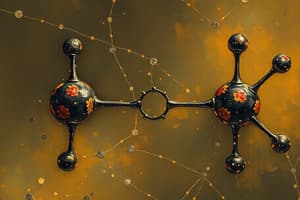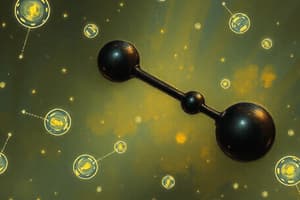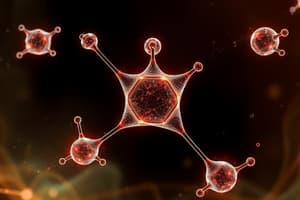Podcast
Questions and Answers
What type of relationship exists between the first pair of molecules shown?
What type of relationship exists between the first pair of molecules shown?
- Diastereomers (correct)
- Constitutional isomers
- Conformers
- Enantiomers
Which type of isomers are represented by the second pair of molecules?
Which type of isomers are represented by the second pair of molecules?
- Conformers
- Enantiomers
- Constitutional isomers (correct)
- Diastereomers
Identify the relationship between the third pair of molecules displayed.
Identify the relationship between the third pair of molecules displayed.
- Diastereomers
- Conformers
- Enantiomers (correct)
- Constitutional isomers
The fourth pair of molecules can be classified as which of the following?
The fourth pair of molecules can be classified as which of the following?
What is the relationship between the fifth pair of molecules?
What is the relationship between the fifth pair of molecules?
What type of isomer relationship is represented by the sixth pair of molecules?
What type of isomer relationship is represented by the sixth pair of molecules?
Which is the correct classification for the seventh pair of molecules?
Which is the correct classification for the seventh pair of molecules?
Determine the relationship for the last pair of molecules shown.
Determine the relationship for the last pair of molecules shown.
What is the relationship between the two halogens in the described molecule?
What is the relationship between the two halogens in the described molecule?
Which of the following is the correct depiction of the chair conformation for the described cyclohexane molecule?
Which of the following is the correct depiction of the chair conformation for the described cyclohexane molecule?
How does flipping the chair conformation affect the positions of the substituents?
How does flipping the chair conformation affect the positions of the substituents?
Which chair conformation, C1 or C2, is likely to be more stable?
Which chair conformation, C1 or C2, is likely to be more stable?
What role does steric strain play in the stability of chair conformations?
What role does steric strain play in the stability of chair conformations?
Which of the following statements accurately describes a chair flip?
Which of the following statements accurately describes a chair flip?
In the context of cyclic compounds, which factor is most crucial for determining stability?
In the context of cyclic compounds, which factor is most crucial for determining stability?
Which of the following best describes a staggered conformation in relation to the described molecule?
Which of the following best describes a staggered conformation in relation to the described molecule?
What is the hybridization of the nitrogen atom in the molecule represented with H-N-C=O?
What is the hybridization of the nitrogen atom in the molecule represented with H-N-C=O?
What is the resonance structure of the compound with the formula N-C=O showing a positive charge on the nitrogen?
What is the resonance structure of the compound with the formula N-C=O showing a positive charge on the nitrogen?
Given the IUPAC name 2,2-dibromo-3,4-diethylhexane, which of the following is a characteristic feature of its structure?
Given the IUPAC name 2,2-dibromo-3,4-diethylhexane, which of the following is a characteristic feature of its structure?
What is the conjugate base of butanoic acid when it loses a proton?
What is the conjugate base of butanoic acid when it loses a proton?
Which of the following statements is true about the bases that can deprotonate ethanol with Keq > 103?
Which of the following statements is true about the bases that can deprotonate ethanol with Keq > 103?
Which atom in the molecule H-N-C=O has a sp2 hybridization?
Which atom in the molecule H-N-C=O has a sp2 hybridization?
In the resonance contributors shown for the compound N-C=O, what is true about the electrons?
In the resonance contributors shown for the compound N-C=O, what is true about the electrons?
Which hybridization is exhibited by the terminal carbon atom in a molecule with the formula R-C(=O)-OH?
Which hybridization is exhibited by the terminal carbon atom in a molecule with the formula R-C(=O)-OH?
What type of reaction mechanism is demonstrated in the provided acid-base reaction?
What type of reaction mechanism is demonstrated in the provided acid-base reaction?
In the given acid-base mechanism, what is the role of the base?
In the given acid-base mechanism, what is the role of the base?
When assigning the configuration of the chiral center at the nitrogen atom, what is the correct designation?
When assigning the configuration of the chiral center at the nitrogen atom, what is the correct designation?
What is the relationship between the two methyl groups in the provided Newman projection for butane?
What is the relationship between the two methyl groups in the provided Newman projection for butane?
Which of the following statements about the provided acid-base reaction is true?
Which of the following statements about the provided acid-base reaction is true?
During the acid-base reaction, which molecule acts as the acid?
During the acid-base reaction, which molecule acts as the acid?
In the context of chirality, which factor can affect the designation of R/S configurations?
In the context of chirality, which factor can affect the designation of R/S configurations?
Which of the following correctly describes a characteristic of Newman projections?
Which of the following correctly describes a characteristic of Newman projections?
Flashcards are hidden until you start studying
Study Notes
Hybridization Assignments
- sp2 hybridization occurs at atoms with one double bond.
- sp hybridization occurs at atoms involved in triple bonds.
- sp3 hybridization is found at atoms with four single bonds.
Resonance Contributors
- Draw resonance structures showing charged carbons and hydrogen attachments.
- Include lone pairs for accuracy in all contributions.
IUPAC Naming
- The molecule referred to is 2,2-dibromo-3,4-diethylhexane, indicating substituents at specific carbon positions within a hexane chain.
Conjugate Bases
- The conjugate base of butanoic acid features the carboxylate structure with negative charge.
Bases for Deprotonation
- Bases capable of deprotonating ethanol (Keq > 10^3) include:
- NH3
- CH3
- Non-usable bases include Br and NH.
Acid-Base Reaction Mechanisms
- Curved arrow mechanisms illustrate electron movement in acid-base reactions, showing proton transfers between molecules.
Chiral Centers
- Assign R/S configurations based on molecular orientation around chiral centers:
- R for clockwise arrangement.
- S for counterclockwise arrangement.
Newman Projections
- A Newman projection for butane shows representations from different perspectives, indicating:
- Anti and gauche relationships between substituents.
- Eclipsed interactions based on spatial orientation.
Molecular Relationships
- Determine relationships including constitutional isomers, conformers, diastereomers, and enantiomers based on structural differences.
Chair Conformation
- Draw chair conformations and chair flips to visualize molecular stability.
- Compare stability between conformations based on steric interactions and equatorial positioning of substituents.
Studying That Suits You
Use AI to generate personalized quizzes and flashcards to suit your learning preferences.




